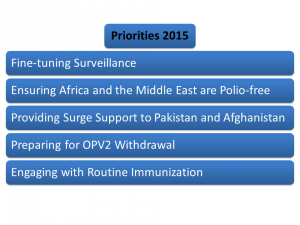Looking Forward into 2015
As 2015 approaches, the GPEI sets priorities to make 2015 the last stand of thepoliovirus around the world.

The last few years have seen the Global Polio Eradication Initiative (GPEI) evolve and grow in response to the threats posed to the world by the final strongholds of the poliovirus. Despite being more geographically limited than ever before, at the end of 2014 the virus continues to pose challenges that must be faced in 2015 if we are to protect children from this disease forever.
We have the tools and the knowledge to tackle each problem that we will face in the coming year, so long as we can maintain the rigour and momentum needed to see the job done. We have more friends than ever before to join us in partnership for the final stages. The following priorities have been set for the partnership to build on the gains made so far and to address the key risks and challenges of the coming year:

Surveillance will be an important theme for 2015. The beginning of December marked four months with no cases of wild poliovirus reported on the African continent, and the outbreak in the Middle East seems to be on track to be stopped with no cases since January in Syria and April in Iraq. But low-level transmission that could be going undetected, in these areas or in parts of central Africa and the Horn of Africa, could derail efforts. Ensuring that reliable surveillance systems are in place will be crucial in ensuring that no cases of acute flaccid paralysis (AFP) are being missed, and that if polio does continue to circulate, that responses can be swift and efficient.
As we move towards the polio endgame, environmental surveillance will become increasingly central to the programme, to supplement AFP surveillance particularly in dense, high-transit urban areas. By remaining vigilant for the presence of poliovirus even where it seems to have stopped circulating will enable the programme to stop potential outbreaks before they begin.
2014 has marked significant progress against the poliovirus in Africa and the Middle East. Nigeria, the only remaining endemic country on the African continent, saw a massive reduction of cases from 53 in 2013 to only 6 in 2014. The outbreaks in central Africa and the Horn of Africa appear to have been brought under control, and no cases have been seen anywhere in Africa in the last four months of the year. In the Middle East, the outbreak that struck in the second half of 2014 has seen no cases since January in Syria, and April in Iraq.
These gains must be carefully maintained. The need to continue to reach every single child with the vaccine and to strengthen surveillance systems so that we can be sure that transmission has stopped is essential in the coming months. Avoiding fresh outbreaks in Africa and the Middle East will rely on the Temporary Recommendations made under the Public Health Emergency of International Concern (PHEIC) to be strongly kept in place to minimise the risk of renewed spread of the virus. Ultimately, however, these are risk mitigation strategies, and the only way to truly eliminate this risk is to complete the job in the remaining endemic areas (from where the virus could spread anew). Until then, all countries should maintain high population immunity levels and strong surveillance, to minimise the consequences of a potential re-infection.
Pakistan is the greatest challenge posed to the global eradication programme in 2015. Pakistan and Afghanistan are the only countries where the number of cases rose in the past year, due to inaccessibility, insecurity, cross-border population movements, operational gaps and the need for increased commitment at all levels.
In 2015, support to Afghanistan and Pakistan will increase in order to bring numbers down and end transmission. In Pakistan, the increased commitment from the government was demonstrated at a planning meeting in November where a strategy was developed for the upcoming low season for poliovirus transmission. The partners of the GPEI will support the government to execute the plan and protect children across the country against polio. The decreasing number of cases elsewhere frees resources to respond to the threat in Pakistan with innovative techniques.
While keeping numbers relatively low in Afghanistan despite the high numbers in neighbouring Pakistan has been a huge achievement, strengthening immunization along the borders and ending the spread of the final strains of virus endemic to Afghanistan will be important priorities for 2015.
The world is gearing up for the phased removal of oral polio vaccines (OPV), beginning with the removal of the type 2 component of trivalent OPV and switching to bivalent OPV. With wild poliovirus type 2 eradicated since 1999, and the bulk of circulating vaccine-derived poliovirus cases (cVDPVs) caused by the type 2 component, this switch will be associated with significant public health benefits. To achieve this, 126 countries are introducing inactivated polio vaccine (IPV) by the end of 2015, and efforts are being intensified to stop persistent type 2 cVDPVs in Nigeria and Pakistan by March. Stopping these outbreaks will be the trigger for the switch, currently planned for April 2016.
The coming year will provide an opportunity to demonstrate and build on the differences that the polio programme makes to routine immunization programmes. Polio continues to exist in countries where routine health services are weak, and routine systems are key in ensuring that every child is reached with the polio vaccine. Staff from the polio programme have therefore always engaged with routine immunization systems.
As we move towards the polio endgame, it is becoming increasingly important to prepare for the transition of staff, expertise and infrastructures for other public health services once polio has been eradicated. In 2015, this planning will scale up, strengthening the already productive relationship between polio and other services.












